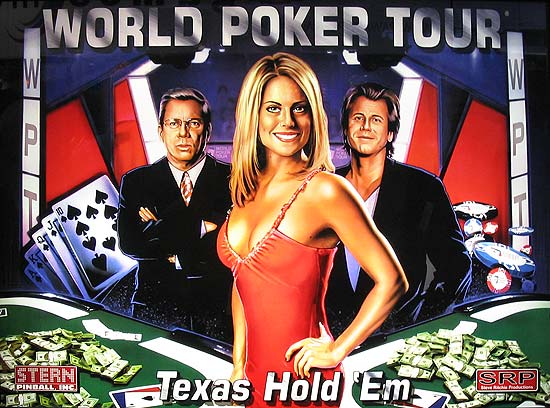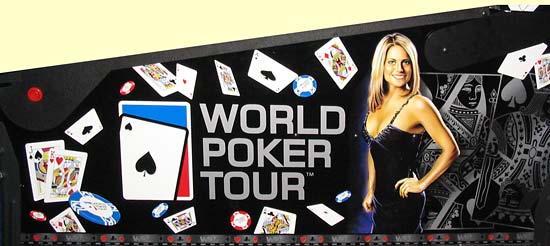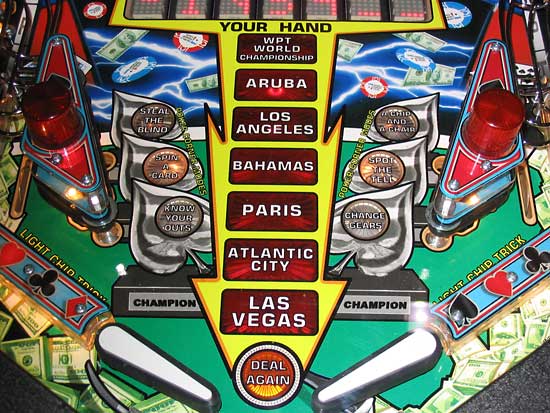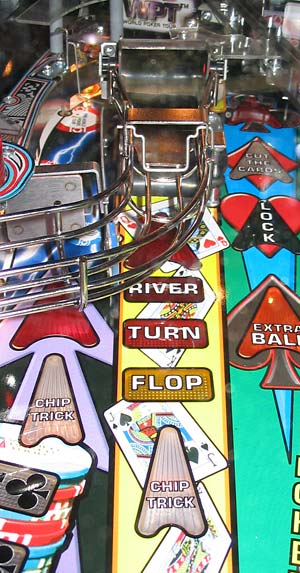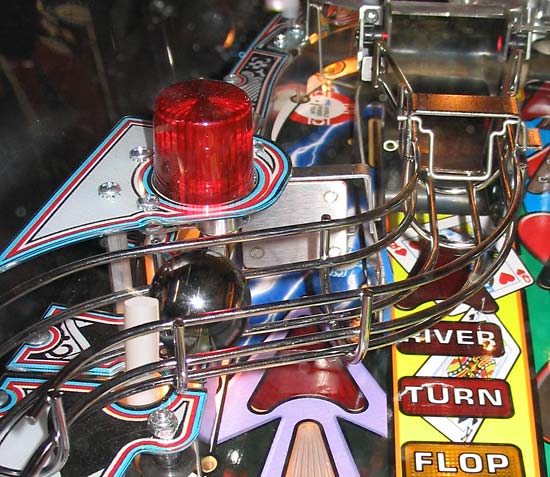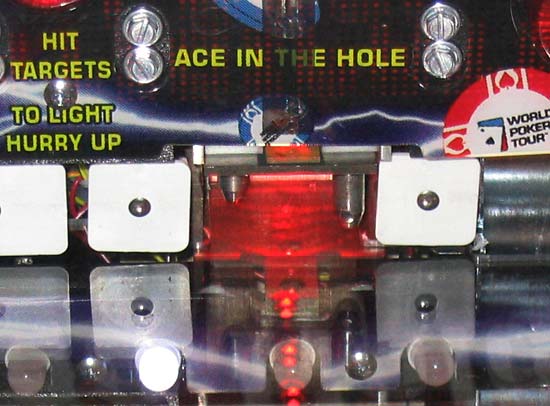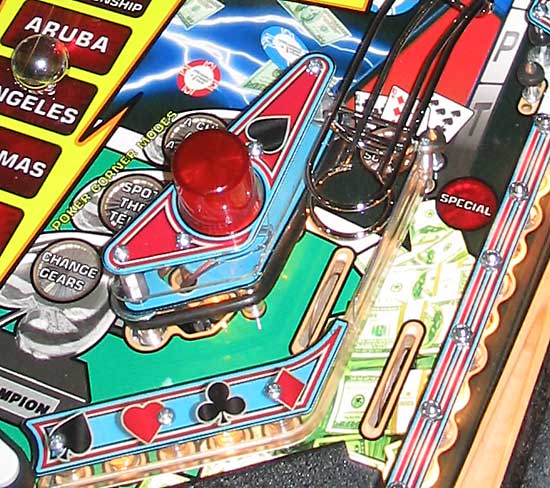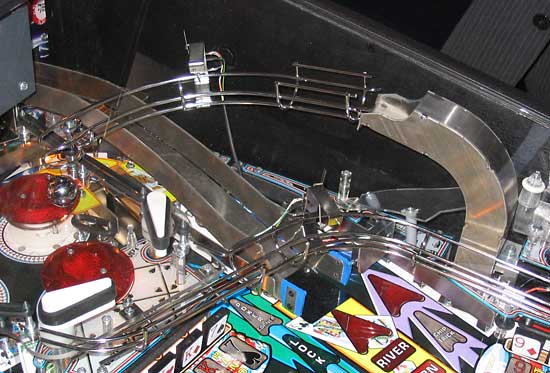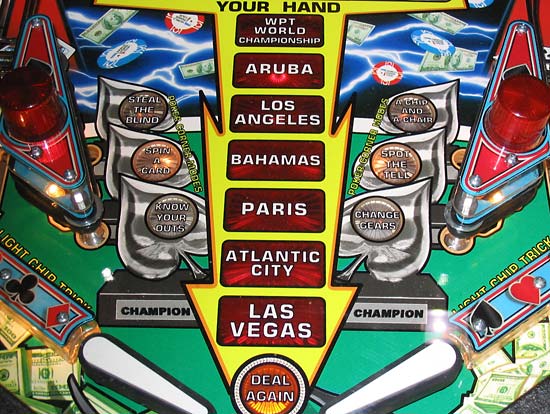|
|
|
WORLD POKER TOUR
|
|
Welcome to this first part of our in-depth look at Stern's newest game, World Poker Tour.
This backglass image was first seen on the preliminary pictures and was assumed to be as preliminary as the rest of the game but it's appeared on every version we've seen so it's probably fair to say it's the final art. It seems strange because the font used for the title isn't the same as the official logo or even the same as the one used elsewhere on the cabinet. You may also be wondering who the people depicted are. Well, they're: (L-R) Mike Sexton, Courtney Friel and Vince Van patten, hosts of the WPT TV show and here's what they really look like courtesy of the WPT website:
I don't think any of them will be especially happy with their depictions on the backglass. Sexton looks like a bitter mean-spirited accountant while Van patten seems to have wandered in from an episode of Miami Vice. Anyway, moving on, the cabinet is attractive if unexciting, featuring the official WPT logo and more of Ms Friel's charms.
The game features a silver trim to the backbox, the usual oversized black side rails, black lockdown bar and legs and a manual ball launcher
Despite being unfinished, the three games at ATEI 2006 were much further advanced than was expected. Almost all the artwork was in the game with the exception of the apron decals, the spinner decals, the art on the black box at the top right of the picture above and the sticker on the shooter lane VUK. The software was much improved from the version seen on test with no obviously missing features and only a few rough-looking display effects. So, let's take a tour of the playfield starting at the flippers and working clockwise.
There are two standard length white flippers here with another two on the upper playfield. The flipper buttons for these are two-stage meaning a gentle press activates just the lower flippers while a harder press also activates the upper flippers. This makes it possible to trap balls on the lower flippers while still playing the upper playfield normally. There is one inlane and one outlane on either side. The outlanes can be lit for special while the inlane automatically lights Chip Trick at the right scoop. The inlane can also be lit for triple scoring. Only one inlane is lit at a time for triple scoring and it can be toggled by the flipper buttons. This is useful as the triple scoring only last for a couple of seconds so you need to use it wisely and not waste it. The left inlane is fed from the left ramp and the right inlane from the right ramp. Directly above the left outlane is the Light Lock target.
No prizes for guessing what this one does. For the first multiball it lights lock at the left scoop and the right scoop. For the second multiball it's only the (harder) right scoop that locks balls and for the third multiball you have to hit the Light Lock target twice to light the locks (the first time you hit it the lamp flashes and a second hit extinguishes it). You can stack locks before collecting them. The Light Lock target is a hard one to hit with any consistency as it requires a very accurate shot. Although it's places above an outlane, it's not a real sucker shot because if you miss you'll most likely hit rubber and send the ball off across the playfield into the drop targets opposite. This is one of those targets that seems to get hit in the normal course of play. Above the Light Lock target is the first bank of drop targets.
There are eight drops in the left bank each representing a card. You shoot these to complete the five-card poker hands. This is separate from the Texas Hold 'Em game played on the displays in the centre of the game and as far as I could see these drops didn't influence the Hold 'Em game in any way. We'll cover the rules for this a little later in this review. Moving round we come to the left loop.
The left loop feeds either the pop bumpers or orbits round to the right loop. It feeds nicely back to the flippers making it a repeatable shot to really get those spinners flying and the pot building. Next to the left loop is the left ramp.
The shot is registered by an opto at the top of the ramp. The wire gate is there to prevent the ball bouncing back when the ball is stopped by a plastic post on the ramp.
This happens just about every time the ramp is made so it interrupts the flow of the game somewhat but it can also be useful during multiball or when you want to concentrate on the upper playfield action instead. Next to the left ramp is the left scoop.
Now we come to the central area of the game consisting of the pop bumpers, the lower and upper target banks, the upper playfield and another bank of drop targets.
Because this is a complicated area, let's get the simple stuff out of the way first.
The four drop targets function just like the previous eight on the left side of the game and help build poker hands towards completing the full set - illustrated on the playfield just below them. Above them are the pop bumpers and the lower target bank.
The bumpers main aim is to throw the ball against the four red standup targets at the back of the playfield. When they are hit a corresponding blue LED lights above each target and completing them all adds a bonus multiplier. They act like rollover lanes but without the rollovers. It is also just about possible for the bumpers to send the ball into the left scoop but it's quite a rarity so don't rely on it. There are five ways to get the balls into the bumpers - shoot them directly just to the right of the left scoop, from either of the two loop shots, from an exit on the upper playfield or from the right scoop kickout. Balls can exit from the bumpers into either the left or the right scoop lanes but the left is more common. Now, above all this is a clear upper mini-playfield.
There are three ways to get the ball onto the upper playfield, firstly as already mentioned, the left scoop kicks balls up here coming out of the hole marked "Light Mystery" in the picture above. Secondly, plunged balls are kicked up here via a wireform you can see on the right had side. Finally, right ramp shots come out under the big black box at the top right. The box contains a down-post to stop the ball while the lit awards on the right ramp are given. The two mini-flippers shoot the ball at the three white standup targets, the Ace-In-The-Hole ball lock and also at the Light Mystery hole. Making the Light Mystery hole lights the Cut The Cards feature at the left scoop and is also the plunger skill shot, while shooting the three white standups starts a hurry up at the Ace-In-The-Hole lock. The Ace-In-The-Hole is the closest WPT gets to a playfield toy so let's look at it in a little more detail.
This is how it looks at the start of the game. Those posts are enough to stop the ball getting in there but you can bash the ball against them to register hits. After sufficient hits, the bars pop up out of the way so you can shoot the ball inside. When you make the shot the bars drop back down turning the ball into a captive ball.
You get served a new ball which you bang into the captive ball to eventually free it and start a multiball. We'll look at the multiball mode later but that's how the Ace-In-The-Hole works. To the right of the three white standups is one of the exits from the upper playfield.
This drops straight down into the pop bumpers with only a flashy animation of the WPT words on the display to console you.
The other way off the upper playfield is between the two mini flippers, onto a metal wireform and down to the right inlane. The gap between the mini-flippers appears quite large but is well judged to make the upper playfield just difficult enough and not too frustrating. Continuing with our tour of the playfield, we come next to the right scoop.
To the right of the right scoop is the right ramp.
The final major shot is the right loop.
Below the right loop entrance is the final group of drop targets.
Not much more to say except these are the targets least likely to get hit during normal play, so if you really need them to make that royal flush you're going to have to shoot for them. We're almost there so let's move on to the right inlane/outlane combo.
It might say special but there's nothing special about this arrangement. The exit from the upper playfield arrives at the inlane where triple scoring can be collected just like the left inlane. It's probably worth noting the triple layer slingshots. The upper and lower levels are printed while the middle is clear. It looks good and gives some much needed height to the lower half of the playfield.
From the shooter lane, the ball is kicked to the upper playfield with what must be one of the ugliest pieces of pinball hardware ever. VUK? More like YUK!
Finally, lets see the big feature of World Poker Tour, the inlaid poker card displays.
Initially only the hole cards are displayed but as you make the ramps to add the flop, turn and river cards your hand fills up. At this point, the hand is completed and you would have ended with a pair of jacks. One of the criticisms of the display I heard was the inability to distinguish between the various suits in the short amount of time you have while the ball is held. I think that's true and perhaps a negative version of the black suits could have worked. In the end though, as we shall see, it doesn't really matter because you actually have no control over the cards anyway. Below the embedded display is a list of different venues where the WPT events are held and where you have to win the tournaments.
You begin at one of the bottom six locations and play hands of Hold 'Em until you are the champion. You need to win one at the first location, two at the second and so on. When you have completed all the lower six you get to play at the WPT World Championship. On either side of the locations are the six Poker Corner modes. In both cases, the completed events are lit solidly and the next one is flashing.
That's all for this look around the playfield. In the next part we'll look at the game's rules and consider the other elements of the game to see how World Poker Tour performs as a package.
© Pinball News 2006 |

